1. Pink Floyd, “Animals” (1977)
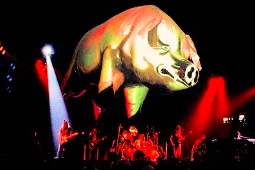
Pink Floyd’s Animals is one of the most visually striking album covers ever created, featuring a massive inflatable pig floating between the towering chimneys of Battersea Power Station in London. The imagery was inspired by George Orwell’s Animal Farm, reflecting the album’s themes of social hierarchy, corruption, and class struggles. According to Farout Magazine, the band hired artist Roger Waters, designer Storm Thorgerson, and the team at Hipgnosis to bring the concept to life. They commissioned a 40-foot helium-filled pig, named “Algie,” to be flown over the power station for the shoot. A trained marksman was stationed nearby in case the pig escaped, but strong winds caused it to break free, floating into the flight paths of Heathrow Airport, causing chaos.
The pig eventually landed in a farmer’s field in Kent, terrifying his cows and making national headlines. Despite the chaos, the incident helped generate significant publicity for the album. The final image on the cover was a composite of different shots from the ill-fated photoshoot. Animals became one of Pink Floyd’s most politically charged albums, criticizing capitalist greed and societal divisions. The dystopian cover, with its industrial setting and surreal airborne pig, perfectly matched the album’s bleak tone. Over the years, Algie has been resurrected for various concerts and promotional events, cementing its place in rock history.
2. The Beatles “White Album” (1968)
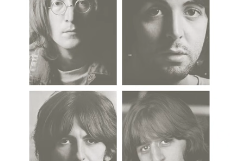
While The White Album is best known for its minimalist white cover, the original 1968 UK vinyl pressings included four glossy portraits of the band members, plus a fold-out poster containing a collage of candid images—including several featuring animals. According to Udiscover Music, the collage, designed by artist Richard Hamilton, included Paul McCartney holding his beloved sheepdog Martha, as well as other wildlife imagery interspersed among psychedelic and abstract elements. The animal imagery subtly reflected the band’s growing connection to nature and their individual lifestyles at the time.
Though the animals weren’t the central focus, these hidden images added a layer of intrigue to the album’s stark and unassuming exterior. Fans who carefully examined the fold-out found visual storytelling woven into the chaotic yet intentional design. The inclusion of Paul’s dog Martha is particularly significant, as she inspired the song Martha My Dear. This unconventional approach to album art reinforced The White Album‘s reputation as an enigmatic masterpiece, full of surprises beyond its plain cover. Over the years, the rare original fold-outs have become collector’s items, adding to the album’s legendary status.
3. Fleetwood Mac, “Tusk” (1979)
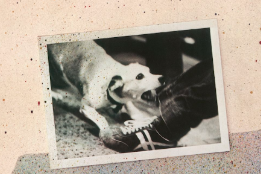
Fleetwood Mac’s Tusk features a raw and seemingly random cover image of a snarling dog biting the pants leg of an unseen person. The photo, taken by drummer Mick Fleetwood’s friend and photographer Peter Beard, was meant to symbolize the wild, chaotic, and unpredictable nature of the double album. It perfectly captured the band’s turbulent relationships, experimental musical direction, and the untamed energy of the recording sessions. According to Wikipedia, the dog, a borrowed pet from a friend of the photographer, wasn’t even originally intended to be on the cover—it was just a spontaneous moment that happened during the shoot.
The image resonated with the band’s state of mind at the time, as they were dealing with the emotional fallout from their personal entanglements. The raw and unpolished aesthetic also aligned with the album’s production, which was deliberately more experimental and stripped-down compared to Rumours. Though Tusk wasn’t as commercially successful as its predecessor, the cover became an iconic representation of artistic defiance and creative risk-taking. Over the years, the dog has become a symbol of Tusk’s unorthodox charm, proving that sometimes the most unexpected images can define an album’s legacy.
4. The Beach Boys—”Pet “Sounds” (1966)
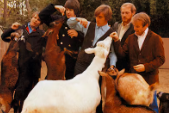
One of the most famous album covers featuring animals, Pet Sounds, depicts The Beach Boys feeding goats at the San Diego Zoo. The cover, photographed by George Jerman, was initially conceived as a lighthearted and literal interpretation of the album’s title. However, according to Wikipedia, Brian Wilson later explained that the title had a deeper meaning, reflecting his admiration for unusual sounds and textures in music. The goats were chosen for their playful and quirky presence, mirroring the experimental nature of the album.
Although the band members look slightly bemused in the photos, the cover has since become one of the most recognizable in music history. Some members reportedly weren’t thrilled with the idea of posing with goats, but Wilson’s vision ultimately prevailed. The animal imagery helped reinforce the album’s warm, organic feel, matching the lush orchestrations and innovative recording techniques that defined Pet Sounds. Over the years, the goats have become synonymous with the album’s status as one of the greatest in rock history.
5. Blink-182—”Cheshire Cat” (1995)
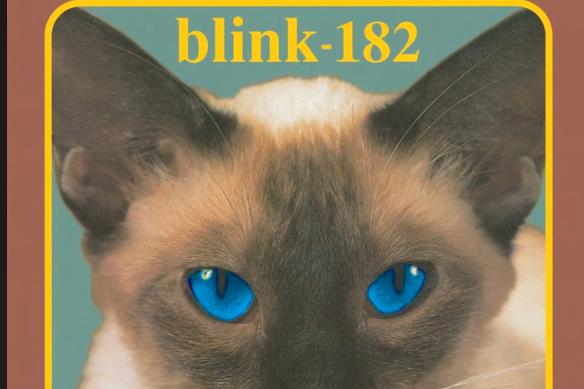
Blink-182’s debut album, Cheshire Cat, features a close-up of a grinning orange tabby cat with piercing blue eyes. The cat’s intense stare and smug expression perfectly match the band’s mischievous, playful, and rebellious spirit. According to Wikipedia, the album, which introduced the world to Blink-182’s raw pop-punk sound, was named after the grinning cat from Alice’s Adventures in Wonderland, reinforcing the surreal and absurdist humor that became a hallmark of the band.
Though the album didn’t achieve massive mainstream success initially, the cover helped establish Blink-182’s visual identity. Fans were drawn to the cat’s oddly hypnotic expression, making it one of the most memorable images in ‘90s punk rock. Over the years, the Cheshire Cat cover has gained a cult following, and the band has referenced it in later projects. The cat remains a symbol of the band’s early DIY attitude, youthful energy, and refusal to take themselves too seriously.
6. Paul McCartney & Wings, “Band on the Run” (1973)
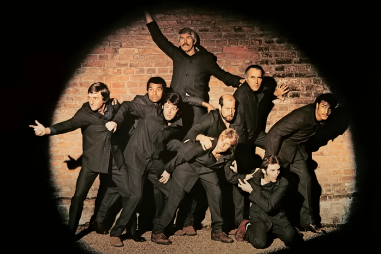
Paul McCartney & Wings’ Band on the Run features an elaborate nighttime photograph of a group of men—including McCartney, his wife Linda, and bandmate Denny Laine—posing as escaped prisoners caught in a spotlight. Though the album itself doesn’t have an animal in its title, the original inner sleeve contains an iconic image of Paul McCartney holding a black Labrador Retriever. The dog, named Jet, inspired the album’s hit song Jet, a track filled with McCartney’s signature whimsical storytelling.
The inner sleeve photo of Paul with Jet became just as legendary as the album cover itself. Jet was a beloved pet of the McCartney family, and Paul later revealed that the song was not only about the dog but also symbolized themes of freedom and youthful rebellion. Fans have long debated the deeper meanings behind the lyrics, but one thing remains certain—the presence of Jet in both the song and the album artwork added an extra layer of personal charm to an already iconic record. The album, considered one of McCartney’s finest post-Beatles works, remains a classic, with Jet’s inclusion making it even more special to fans.
7. King Crimson, “Lizard” (1970)
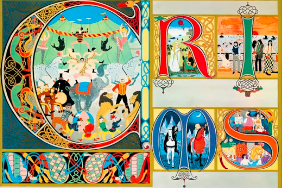
King Crimson’s Lizard is an avant-garde progressive rock masterpiece, and its surreal album cover is equally mesmerizing. The artwork, painted by Gini Barris, is a medieval-style illustration filled with intricate details, including depictions of lizard-like creatures, birds, and other strange animals intertwined within elaborate calligraphy. The cover’s fantastical imagery reflects the album’s complex and experimental nature, blending rock, jazz, and classical influences into something entirely unique.
The title Lizard itself evokes a sense of mystery and transformation, mirroring the album’s shifting musical landscapes. The presence of fantastical creatures on the cover reinforces the album’s dreamlike and almost mythical atmosphere. Barris’s artwork was praised for its meticulous attention to detail, with fans discovering new elements in the design even after repeated viewings. Lizard remains one of King Crimson’s most underrated records, and its album cover continues to be a masterpiece of surrealist album art, drawing listeners into its intricate and otherworldly world.
8. Def Leppard, “Hysteria” (1987)
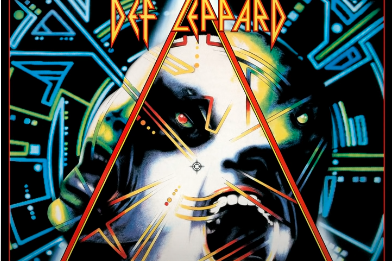
While the original cover of Hysteria features a cybernetic design with a screaming face, a lesser-known but beloved version of the album featured an alternative cover starring Doberman Pinscher. This image appeared on a special edition of the album released in Japan and later became an iconic part of the band’s imagery. The snarling Doberman was chosen to reflect the album’s aggressive, high-energy rock sound and its themes of survival and determination.
The dog’s fierce expression mirrored the band’s struggles and triumphs, particularly drummer Rick Allen’s perseverance after losing his arm in a car accident before the album’s recording. Fans of Hysteria have embraced the dog imagery as a representation of the band’s resilience and power. The Doberman became so closely associated with Hysteria that it has appeared on various merchandise and re-releases over the years. Though not as widely recognized as the original cybernetic cover, the Doberman edition remains a favorite among collectors.
9. Weezer, “Raditude” (2009)
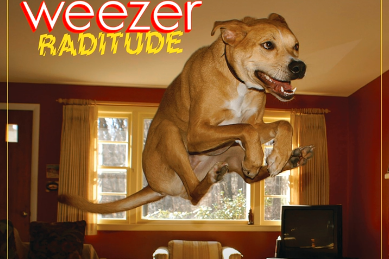
Weezer’s Raditude features one of the most lighthearted and energetic album covers of all time—a mid-air photograph of a small dog seemingly flying through a living room. The dog, a Pomeranian named Sidney, was captured in mid-leap, perfectly embodying the album’s playful and carefree spirit. The image was sourced from a National Geographic photo contest and chosen by the band for its pure joy and absurdity.
The cover became an instant hit among fans, with many adopting Sidney as an unofficial Weezer mascot. The album itself featured a more mainstream, pop-rock sound compared to the band’s earlier work, and the cover’s humorous and endearing vibe matched its upbeat nature. Sidney’s gravity-defying leap remains one of the most memorable album images of the 2000s, proving that sometimes an unexpected and spontaneous photo can perfectly capture the essence of a record.
10. Gorillaz, “Demon Days” (2005)
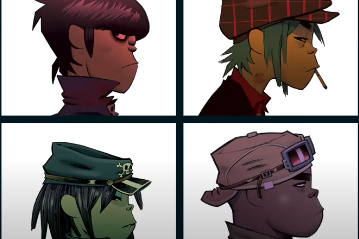
While the standard Demon Days cover features the stylized portraits of the animated band members, a limited edition release included an alternative cover with a dark and eerie image of a monkey’s face. This version was a nod to the album’s themes of evolution, primal instincts, and the chaos of modern society. The primate’s intense expression gave the cover a haunting and almost unsettling quality, reflecting the album’s darker tone.
Gorillaz, known for their inventive and ever-changing visuals, used the monkey as a metaphor for humanity’s duality—our intelligence and creativity alongside our more primitive, destructive tendencies. The Demon Days monkey cover became a sought-after collector’s item, adding another layer of mystique to an already legendary album. While the standard cover remains the most recognizable, the monkey version stands as one of the most intriguing alternate album artworks in modern music.


